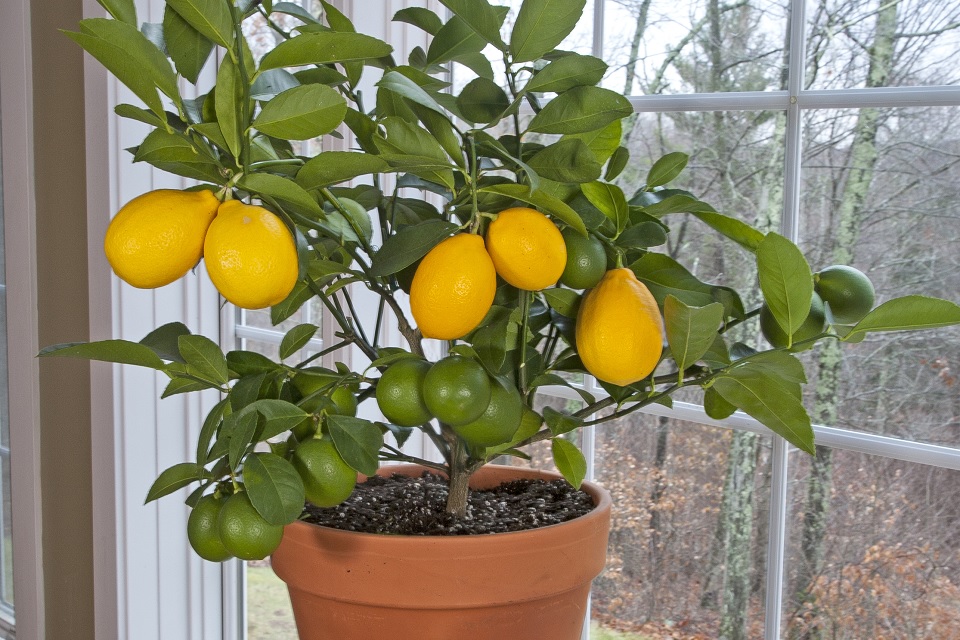
Enjoy Growing Citrus, Even in Tennessee
UT Gardens’ November 2019 Plant of the Month: Indoor Citrus
Submitted by Margeaux Emery, Senior Editor/Writer, UTIA Marketing and Communications
Oranges, lemons and limes are members of the genus Citrus, which is part of the rue family. The fruit is native to southern Asia, Malaysia and Australia. Humans began moving citrus from these regions during some of the earliest migrations of ancient times. The fruits’ history, in fact, is every bit as colorful as its skin. Romans cultivated citrus trees across their territory. Traders on the Silk Road bartered in them, and Spanish conquistadores brought them to Florida. George Washington grew them at Mount Vernon.
You can enjoy a citrus tree of your own in just the way our first president did by growing the plant in a container. Bring the pot indoors well before the first frost and return the plant to the outdoors in spring after the weather is reliably above 50 degrees. Whether you choose an orange, lemon or lime tree, citrus offer the excitement of watching tiny fruit grow and mature. Plus, citrus blossoms offer a heavenly fragrance.
The following varieties do well as indoor citrus grown in pots. Look for them at area plant nurseries and garden centers:
• Improved ‘Meyer’ lemon (Citrus x meyeri ‘Improved’) is a luscious lemon-orange hybrid with a very thin skin and sweeter pulp than other types of lemons. The plant has dark, shiny leaves.
• Calamondin (Citrofortunella microcarpa or Citrus madurensis) is grown largely as an ornamental because its small, round, orange fruit are sour. ‘Peters’ is an eye-catching variegated form.
• ‘Trovita’ orange (Citrus sinensis) grows medium-small, flavorful fruit that ripens quickly. The plant often is alternate bearing.
• Kaffir lime (Citrus hystrix) is an exotic citrus prized for its fragrant leaves that are used in Thai and other Southeast Asian cooking. It does produce a small, bumpy green fruit. Kaffir trees have striking foliage where one leaf appears to grow from another.
Care
Citrus need quick-draining, somewhat acidic soil. Cactus mix works well. Use a well-draining, deep pot to help stabilize the tree, and size pots up as the plant grows. Keep soil moist, but not sodden. When the tree is indoors, less water will be needed because growth slows. Adding humidity to the dry indoor air, though, is important. Mist regularly and consider using humidity trays or a small humidifier.
Citrus trees need 8 to 12 hours of sun a day. Choose a spot outdoors that’s out of strong winds. A site near a heat source, such as a brick wall, is beneficial. Indoors, place the tree in a sunroom or the sunniest window you have, keeping it out of drafts. Use of grow lights will extend short winter days, and the added light is important for fruit production. Expect some leaf and fruit drop to occur as the plant adjusts to being indoors. Once back outside, though, the tree will rebound quickly. Acclimate the tree across a week or more each time you move it indoors and out. In fall, first move the tree from sun to dappled light, then to shade. Reverse the process in spring.
Citrus are heavy feeders. Specialized citrus/avocado fertilizers can be found, yet any all-purpose fertilizer with at least a 2-1-1 ratio can be used, as can fertilizers sold for acid-loving plants. Choose a granular, slow release formulation, although diluted soluble fertilizers can be applied when the plant is actively growing.
While citrus are generally healthy, there do attract a few pests. Spider mites often appear in late winter. Spray them with a water solution to which a squirt of dishwashing soap has been added. Heavier infestations may require horticultural soap or oil. Once the tree is outdoors, keep watch for scale. Ants can aggravate scale infestations. Lower that risk by use of ant traps or by applying a 3- to 4-inch band of sticky insect barrier such as Tanglefoot® around the trunk near the tree’s base. The occasional aphid or two can be brushed away by hand.
The UT Gardens includes plant collections located in Knoxville, Jackson and Crossville. Designated as the official botanical garden for the State of Tennessee, the collections are part of the University of Tennessee Institute of Agriculture. The Gardens’ mission is to foster appreciation, education and stewardship of plants through garden displays, educational programs and research trials. The Gardens are open during all seasons and free to the public. For more information, see utia.tennessee.edu/state-botanical-garden/.